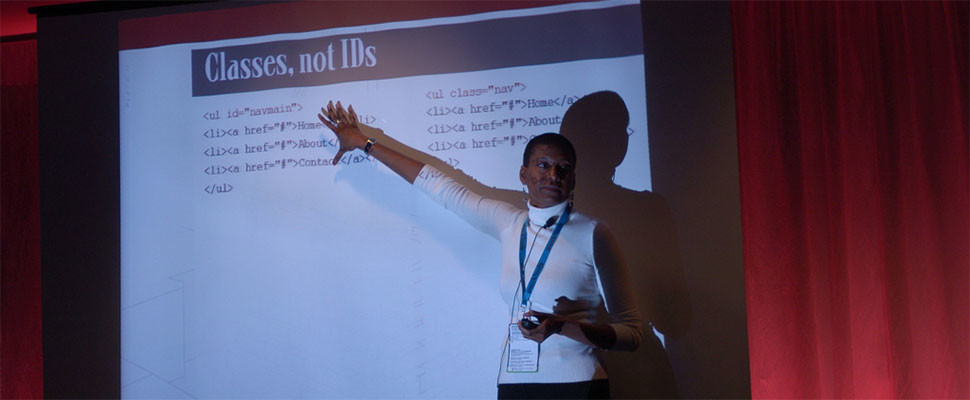CSS3 Training
From 2010 to 2012, I taught a full-day workshop on CSS3 to developers at Intuit through Knowledge United. The course covered the full range of CSS3 properties as well as techniques for page layout, CSS troubleshooting, and graceful degradation to IE6.
Goals/Course Outcomes
After completing this course students will:
- be able to recognize CSS3 selectors, properties and values
- be able to employ CSS3 selectors, properties and values in HTML-based pages
- understand the differences between CSS1, CSS2, and CSS3 selectors
- be able to recognize and employ all of the CSS selector combinators
- be able to utilize advanced CSS2 and CSS3 selectors to better target page elements
- understand the difference between and uses for the various @ rules
- be able to use various CSS3 properities such as border-radius, @font-face, transform and transition, gradient, box- and text-shadow, opacity and rbga, etc. in HTML-based pages
- understand the difference between graceful degradation and progressive enhancement
- learn CSS3 cross-browser and graceful degradation coding techniques
Courses Taught at SCCC
From 2000 to 2005, I taught Web Design and Web Development at Seattle Central Community College. It was one of my favorite jobs in the world. I loved teaching — but hated grading the papers.
-
Web 110 – Web Authoring I
This course covers the mechanics of web page production starting with the absolute basics. Topics covered include: document structure and hierarchy, text elements, list elements, links, tables, working with images, creating framesets and forms. Focus will be on creating HTML files “by hand” using a simple text editor, with emphasis placed on HTML validation and correct HTML 4.0 syntax.
-
Web 120 – Web Authoring II
This course covers more advanced elements of Web page development and production. Topics include a complete review of basic to intermediate HTML and XHTML, page validation using doctypes, writing accessible web pages, cascading style sheets for text formatting and layout, javascript for image rollovers and drop-down menus, handling multimedia files, and using environmental variables/server-side includes.
-
Web 200 – Theory of Web Design
This course gives an overview of the basic principles and practices of professional web site design. Topics covered: site layout and organization, the readability of pages, access issues for a wide audience, hyperlink usability, the use of color, graphics and multimedia, increasing the speed of your site, usability testing, and creating website prototypes.
-
Web 205 – Web Careers Strategies
This course presents various tools and skills needed to transition in to the web industry. Through exercises and assignments, students will hone their ability to structure thinking about launching their future web careers, to best present their skills, and to find appropriate positions.
-
Web 210 – Advanced Web Design
This course focuses on using HTML for web site design including principles of graphic and information design and effective web site navigation, as well as advanced HTML features like cascading style sheets and javascript (DHTML). Students develop a web site in teams, practicing web production workflow in the process.
-
Mic 102i – Computer Lab Survival Skills
This course provides the student with a brief introduction to how to use the computer facilities at the computer lab. Topics to be covered include an overview of computer lab procedures, choosing the correct printer, learning to use email, basic Windows features, and an introduction to Microsoft Windows, Excel, Internet browsers (IE and Netscape).
-
Mic 102d – Introduction to Dreamweaver
This course provides the student with an introduction to using Macromedia DreamWeaver. Topics include: palette and tool use, page creation, site creation, creating navigation elements and javascript rollovers.
-
Mic 102e – Introduction to Excel
This course provides the student with an introduction to using Microsoft Excel.
-
Mic 102t – PowerPoint
This course provides the student with an introduction to using Microsoft PowerPoint, including Naming and saving files, Creating and formatting presentations, Printing presentations, Use of help feature.
-
Mic 102x -Windows Survival Skills
This course provides the student with a brief introduction to how to use MS Windows computers. Topics to be covered include: an overview of windows, file management, customizing your desktop, and an introduction to Microsoft Word.
-
Mic 298 – Web Design Independent Study
This independent study course is designed for students to have the practical experience of designing, building, and maintaining a real website. The course is structured around weekly meetings to share information and resources, group problem-solving and brainstorming, and further sharing of resources through email.
-
Itc 1161w – Supporting MS Word
This course is designed to provide a solid foundation in using and supporting Microsoft Word, as well as a thorough knowledge of Microsoft Word required to support and train others in its use. It also provides preparation for the Microsoft Office User Specialist Exam in Word XP.









